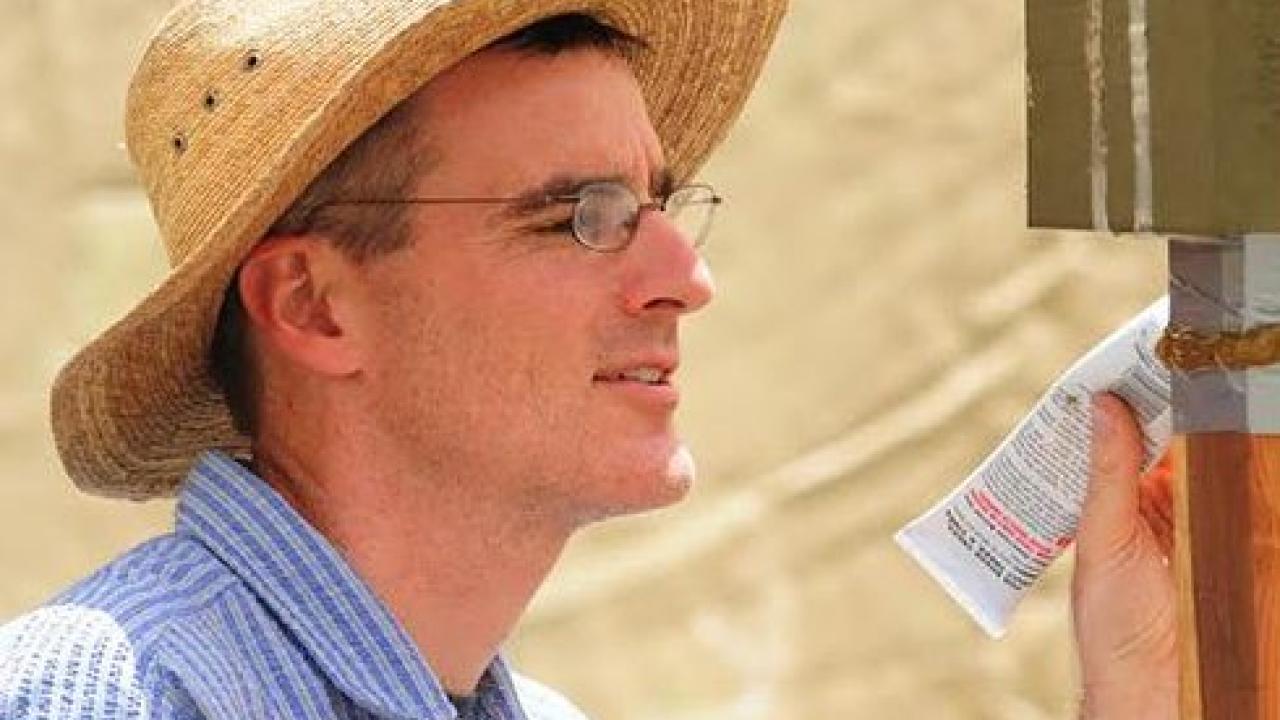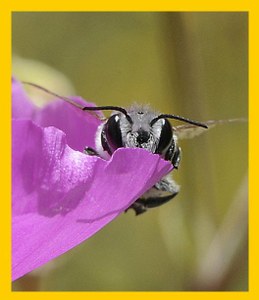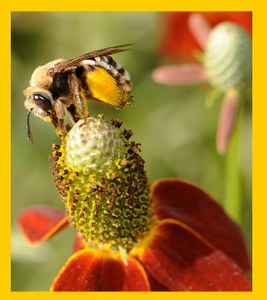
Champion of the alternative bee
Jul 11, 2014 — Kathy Keatley Garvey — University of California, Davis
Wild bees and honey bees pollinate crops; pollinator conservation is important.
University of California, Davis
July 11, 2014
When it comes to almond pollination, it’s more the merrier for growers when wild bees work alongside honey bees, says pollination ecologist Neal Williams.
For Williams, pollination isn’t just a buzzword.
"Pollination by bees is a critical input to many crops — as essential as irrigation, fertilizer or labor," says the associate professor of pollination and bee biology in the UC Davis Department of Entomology and Nematology.
One of Williams’ main goals is to provide practical information to California farmers for improving the long-term stability of pollination. He also wants to promote pollinator conservation and management.
Blue orchard bees and bumble bees
Focusing on “alternative managed” bees, such as blue orchard bees and bumble bees, Williams likes to point out that on a per-bee basis, bumble bees are more effective than honey bees in pollinating tomatoes and watermelons. And the blue orchard bee is used to pollinate California’s No. 1 crop, almonds.
Williams advocates that national and global strategies be developed to support the diversity of bees and to enhance their habitat, especially with the decline of honey bees and bumble bees.
He cites crucial facts:
- Thirty-five percent of primary food crops benefit from animal pollinators.
- The global value of pollination surpasses $220 billion per year. In the United States alone, honey bees account for $14.6 billion, and wild or nonmanaged bees, more than $3 billion.
Making honey bees more effective

Male leafcutter bee peers over a rock purslane blossom. (photo: Kathy Keatley Garvey/UC Davis) - Williams was part of an international research team that found that honey bees are more effective at pollinating almonds when other bee species, including the blue orchard bee, are present.
- The groundbreaking research, which took place in California’s almond orchards in Yolo, Colusa and Stanislaus counties, “is especially important because it increases the pollination effectiveness of honey bees as demand for their pollination service grows,” Williams said.
The researchers discovered that when blue orchard bees and wild bees are foraging with honey bees in almond orchards, the behavior of honey bees changes, resulting in more effective pollination for “this challenging crop.”
Research spanning the disciplines
Williams’ research on pollination spans the disciplines of conservation biology, behavioral ecology and evolution. A primary element of his research focuses on sustainable pollination strategies for agriculture. His interest in sustainability, in fact, has made him a core faculty member of the UC Davis Agricultural Sustainability Institute.
That research involves:
- How native pollinators help alleviate the stress on honey bees and also suggests ways to more sustainably manage agricultural systems;
- How farmers enhance habitat and diversify agricultural systems to promote managed and wild bees; and
- Whether pollinators interact in ways to increase the overall effectiveness of crop pollination.
Williams’ past research in the Eastern and Western U.S. helped form the basis for the U.S. Department of Agriculture’s Natural Resources Conservation Service planting guidelines to enhance pollinators in agriculture.
Developing bee habitats

Currently, Williams is looking at how landscape affects pollinators.
“Although other colleagues in our region investigate the importance of habitat for bees, we are unique in developing methods to identify best plants for bees and then applying these methods to select the plants,” Williams said.
His lab’s approach involves extensive field data, original computational modeling and controlled experimental testing. They are also testing how the resulting native plant mixes perform in real landscapes.
Working with growers
The Williams lab is working with more than 20 different growers and landowners in California and a variety of different crop types from orchard to row crop.
“We have helped to determine best practices for planting bee habitat, protocols for monitoring pollinator use and developed widely used methods for assessing pollinators’ contribution to pollination service,” he said.
The lab is compiling a database on “Honey Plants of California,” to be posted on the Harry H. Laidlaw Jr. Honey Bee Research Facility website. It will include plant type, common name, genus, species, drought tolerance, honey value, honey color, pollen value and flower color.
Taking his practical findings to the next level, Williams says his next goal is to work with theoreticians to model bee communities and pollination.
(This article was written by Kathy Keatley Garvey, communications specialist for the Department of Entomology and Nematology at UC Davis, as part of UC Davis Today.)
Media contacts:
- Neal Williams, Dept. of Entomology and Nematology, UC Davis, nmwilliams@ucdavis.edu
- Kathy Garvey, Dept. of Entomology and Nematology, UC Davis, kegarvey@ucdavis.edu